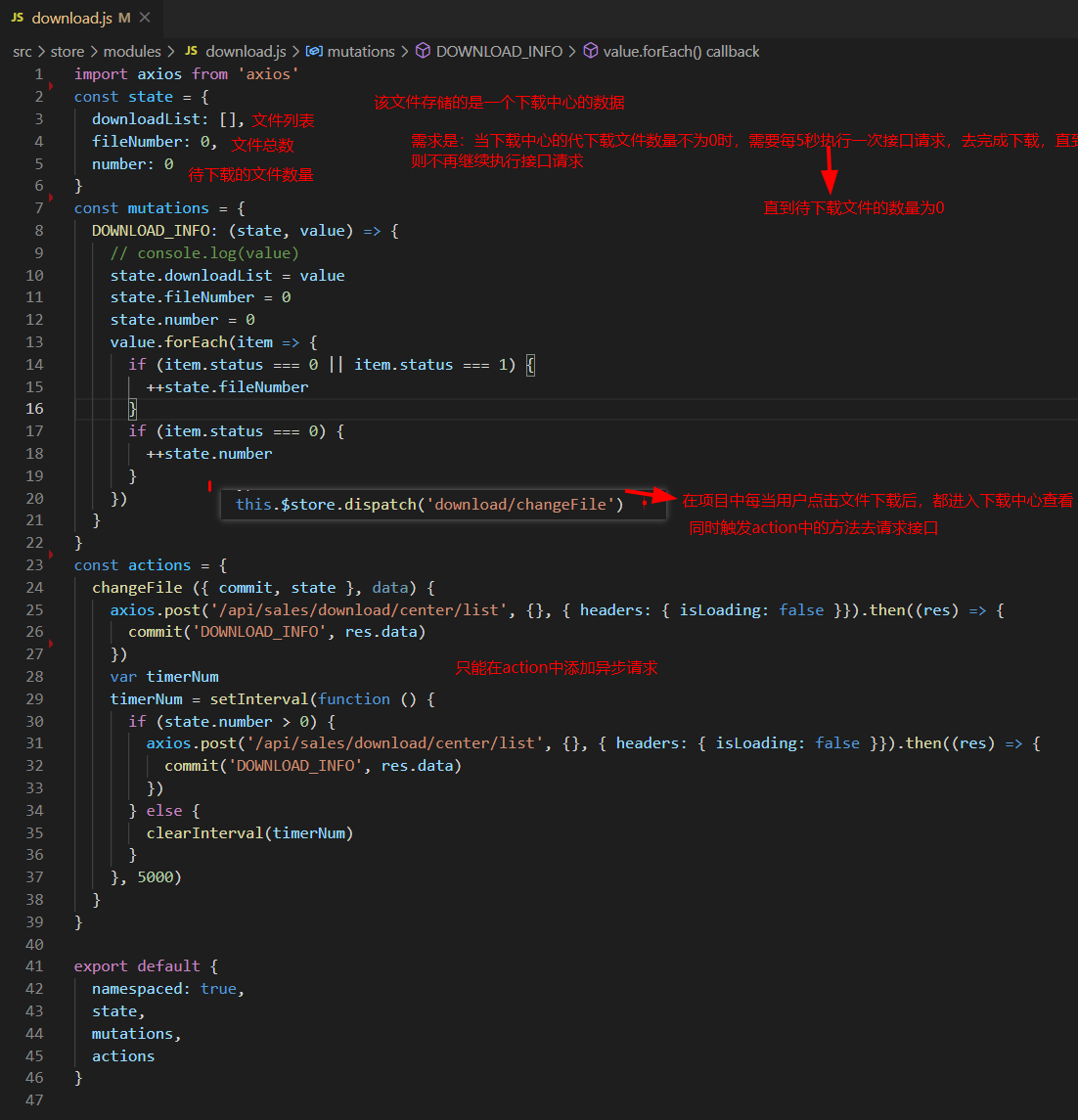Vuex 是一个 Vue.的状态管理模式。它采用集中式存储管理应用的所有组件的状态。
基于父子、兄弟组件,我们传值可能会很方便,但是如果是没有关联的组件之间要使用同一组数据,就显得很无能为力,那么vuex就很好的解决了我们这种问题,它相当于一个公共仓库,保存着所有组件都能共用的数据。
1.Vuex的状态存储是响应式的,当Vue组件从store中获取状态的时候,若store中的状态发生变化,那么相应的组件也会相应地得到高效的更新
2.你不能直接改变store中的状态。改变store中的状态的唯一途径就是提交(commit) mutation。这样使得我们可以方便的跟踪每一个状态的变化。
Vuex有五个核心概念:
state getters mutations actions modules
1.state: vuex的基本数据。用来存储变量
2.getter:从基本数据(state)派生的数据(依赖state得到新的数据)相当于state的计算属性
3.mutation: 提交更新数据的方法,必须是同步的(如果需要异步使用action)
4.action: 和mutation的功能大致相同,不同之处在于------->action提交的是mutation,而不是直接变更状态,action可以包含任意异步操作 ,action中的方法默认的就是异步,并且返回promise
5.modules:模块化vuex,可以让 每一个模块拥有自己的state, mutaion,action,getters,使得结构非常清晰,方便管理
步骤:
1.使用 npm install vuex --save 安装vuex
2. 在项目中建立一个store文件夹
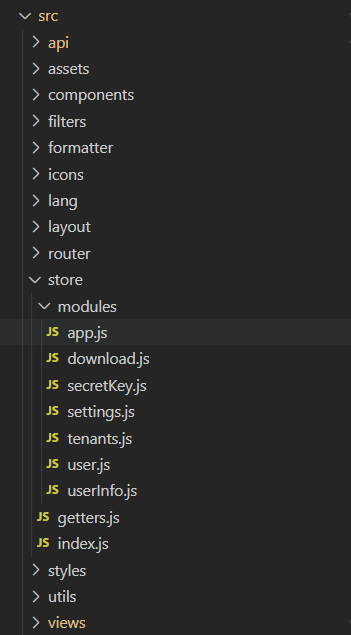
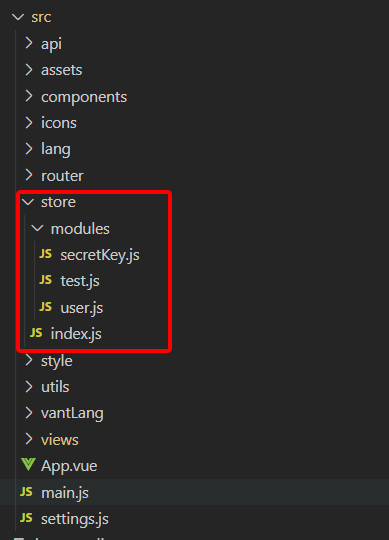
3.在main.js文件中引入store中的index.js,同时在vue中注册store
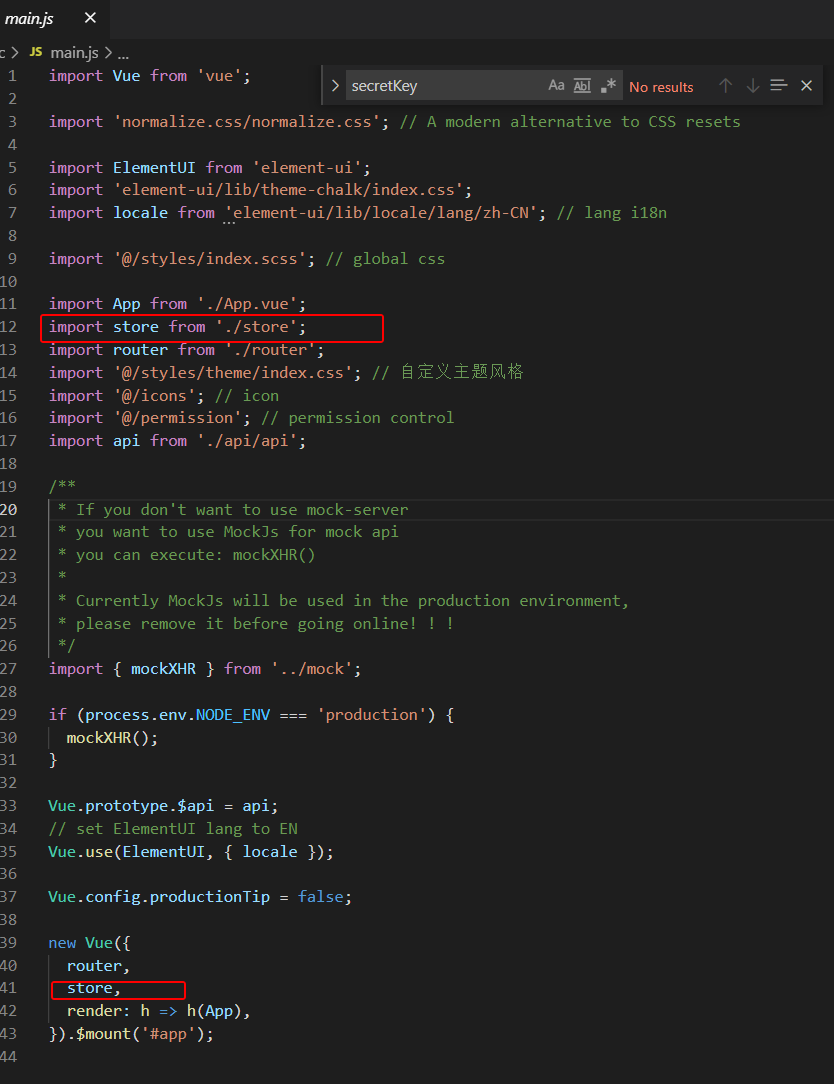
4.在store文件夹中的index.js文件中引入vuex,通过 Vue.use() 来安装 Vuex。
并把modules文件夹中的各个文件引入,完善new Vuex.Stroe中的modules对象.

5.在modules 中的每个js文件中定义自己模块的state, mutaion,action,getters。
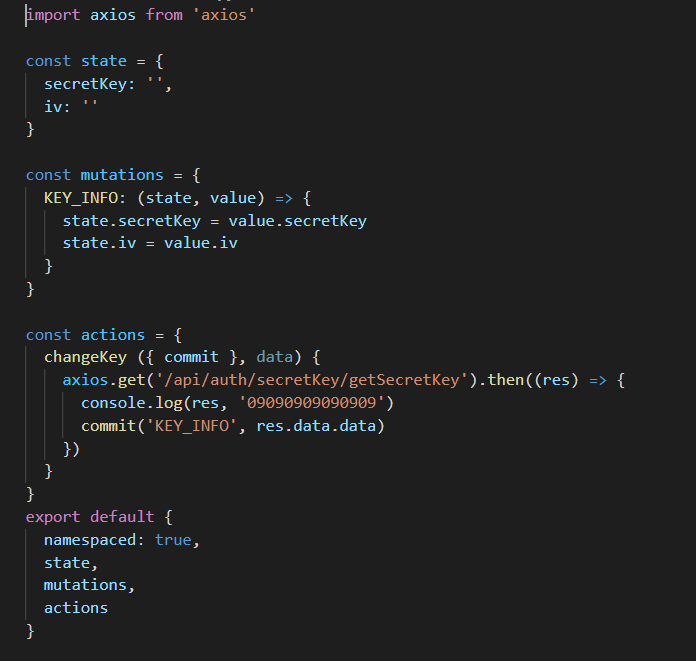
6.在组件中获取store中某个文件中的state中的属性
语法就是:this.$store.state.注册在modules对象中的属性名.该文件state中的属性
这个是获取secretKey.js文件中的state中的secretKey属性

7.触发store中的方法
语法就是:this.$store.dispatch('注册在modules对象中的属性名/该文件中的方法名')
这个是执行secretKey.js文件中的action中的changeKey方法

再来看个例子:
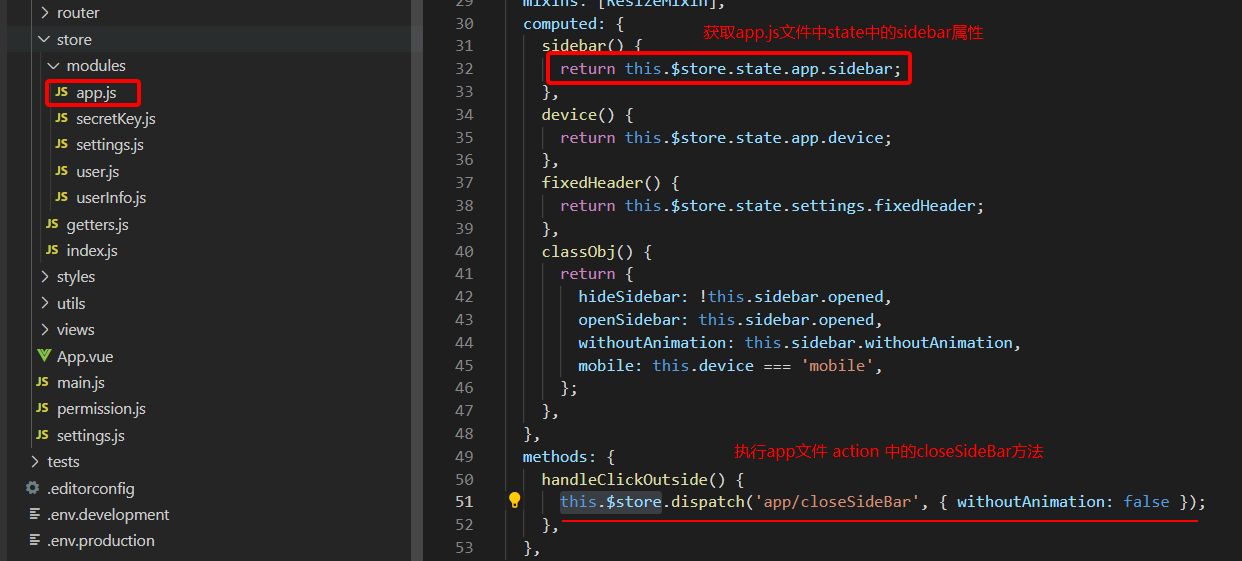
再看一下app.js文件的内容:
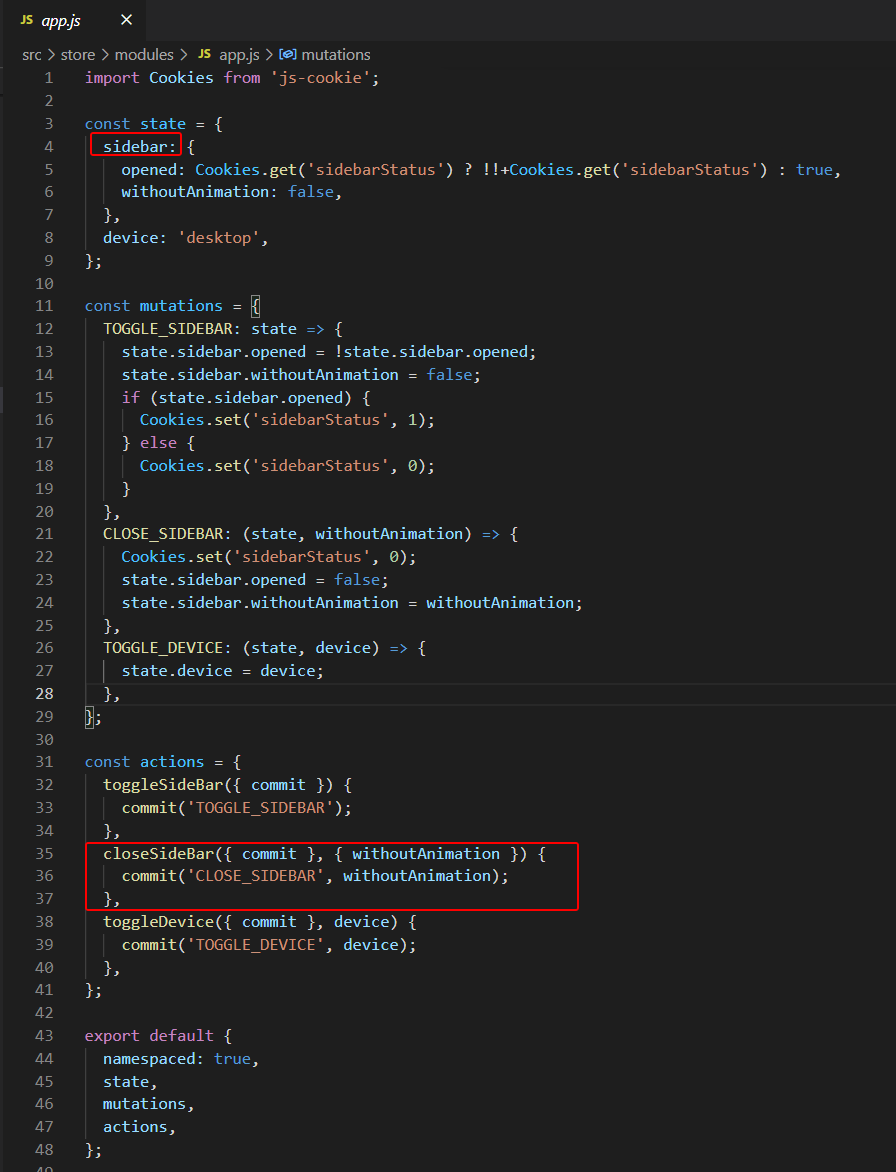
总结一下:mutations 和 actions 中的函数入参
1.mutations中的函数接受两个参数,分别时state和传入的额外参数,这个额外的参数可以是基本类型也可以是一个对象


2.Action 函数接受一个与 store 实例具有相同方法和属性的 context 对象,context可以理解为它是整个Store的对象.类似于this.$store,它里面包含了state,getter,mutations,actions
因此你可以调用 context.commit 提交一个 mutation,或者通过 context.state 和 context.getters 来获取 state 和 getters。

实践中,我们会经常用到 ES2015 的 参数解构 来简化代码(特别是我们需要调用 commit 很多次的时候)这时函数接受两个参数{commit, state} 和额外传入参数data(可以是基本类型也可以是对象)


总结一下:Vuex的辅助函数mapState, mapAction, mapMutations的用法
1. mapState 辅助函数(定义在computed中)
import Vue from 'vue' import Vuex from 'vuex' Vue.use(Vuex) export default new Vuex.Store({ state: { //存放状态 nickname:'Simba', age:20, gender:'男' }, mutations: {}, actions: {}, modules: {} })
有了vuex,我们不必在考虑组件之间的传值,直接就可以通过$store来获取不同的数据,但是如果需要vuex中的多个数据的这时候,这样写就太啰嗦了,我们可以将它定义在computed中。
Props,methods,data和computed的初始化都是在beforeCreated和created之间完成的。
<template> <div class="home"> {{nickname}} </div> </template> <script> export default { name: 'home', computed:{ nickname(){ return this.$store.state.nickname } } } </script>
但是computed中定义的代码还是很多,而这时候vuex又给我们提供了更简便的方法mapState方法
import {mapState} from 'vuex'
export default {
name: 'home',
computed: mapState(['nickname','age','gender'])//映射哪些字段就填入哪些字段 映射过来的字段直接可以用this.xx(字段名)使用
}
记住:用mapState等这种辅助函数的时候,前面的方法名和获取的属性名是一致的。
如果我们需要自定义一个计算属性怎么办呢?怎么添加呢?
毕竟现在已经成这样了 computed: mapState(['nickname','age','gender'])
这时候我们就需要es6中的展开运算符:...
computed: { value(){ return this.listData }, ...mapState(['nickname','age','gender']) }
二、mapGetters 辅助函数 (定义在computed中)
getters相当于vue中的计算属性,通过getters进一步处理,得到我们想要的值,而且允许传参,第一个参数就是state
import Vue from 'vue' import Vuex from 'vuex' Vue.use(Vuex) export default new Vuex.Store({ state: { //存放变量 nickname:'Simba', firstname:'张', lastname:'三丰', age:20, gender:'男', money:1000 }, getters:{ realname(state){ return state.firstname+state.lastname }, money_us(state){ return (state.money/7).toFixed(2) } }, mutations: {}, actions: {}, modules: {} })
computed: { valued(){ return this.value/7 }, ...mapGetters(['realname','money_us']) }
3.mapMutations辅助函数(定义在methods中)
mutations需要通过commit来调用其里面的方法,它也可以传入参数,第一个参数是state,第二个参数是载荷(payLoad),也就是额外的参数
mutations: { //类似于methods
addAge(state,payLoad){
state.age+=payLoad.number
}
}
// js部分 methods:{ test(){ this.$store.commit('addAge',{ number:5 }) } }
调用的时候第二个参数最好写成对象形式,这样我们就可以传递更多信息。
但是,这样写还是会遇到同样的问题,就是如果需要操作多个数据,就会变的麻烦,这时候我们就需要mapMutations,通过它将方法映射过来,映射过来的方法直接可以用this.xx(方法名)使用
methods:{ ...mapMutations(['addAge']) }
参数我们可以在调用这个方法的时候写入 <button @click="addAge({number:5})">测试</button>
4.mapActions辅助函数(定义在methods中)
actions: { getUserInfo(){ return { nickname:'Simba', age:20 } } } methods:{ ...mapActions(['getUserInfo']) }
mapActions(['getUserInfo']) 相当于以下代码
getUserInfo(){ return this.$store.dispatch(‘getUserInfo’) }
补充:使用常量替代Mutation事件类型
把原本的方法名称由字符串转变成常量
优点是:不容易写错,字符串容易写错,而且字符串写错以后不会报错位置,而用常量替代,如果写错,eslint可以提示错误位置
mutations: { //类似于methods
[ADD_AGE](state,payLoad){
state.age+=payLoad.number
}
}
//将addAge方法名字定义为一个常量,当调用的时候直接引入 import {ADD_AGE} from '../store' import {mapMutations} from 'vuex' export default { methods:{ ...mapMutations([ADD_AGE]) } }
数据持久化:
vuex里面存放的数据,页面一经刷新就会丢失
解决方法:
1.存放在localStorage或者sessionStorage里面,进入页面时判断是否丢失,丢失再去localSorage或者sessionStorage里面取。
2.在app.vue根组件的created里面判断是否丢失,在进行上面的操作
3.使用vuex-persistedstate插件
npm install vuex-persistedstate
之后在store文件夹中的index.js文件中引入
import persistedState from 'vuex-persistedstate' export default new Vuex.Store({ getters, state, actions, mutations, plugins: [persistedState()] })
看一下项目中的vuex-persistedstate使用,并且把vuex存储在了sessionStorage里面了:
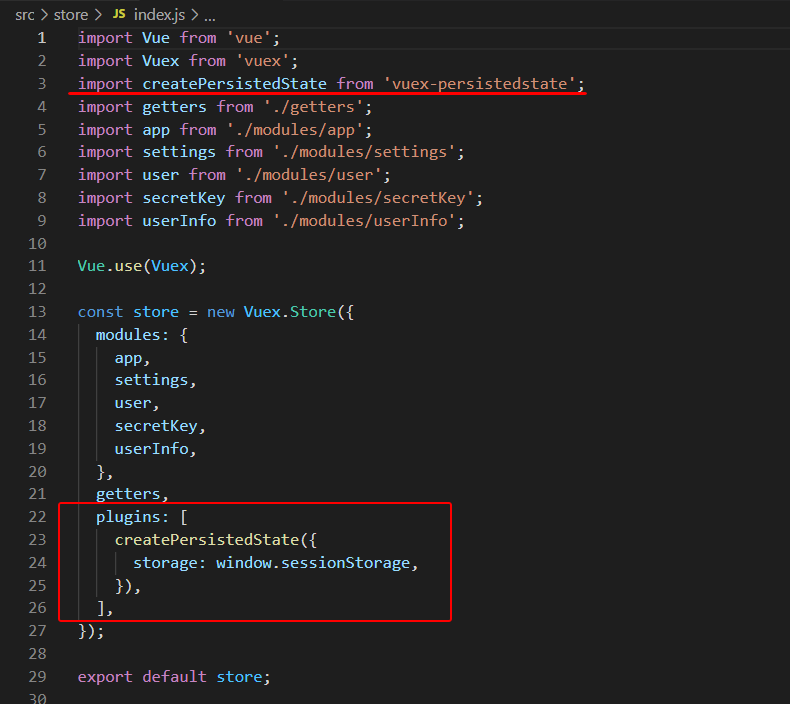

最后再来一个补充:mutation里面只有同步函数,action可以执行异步函数,看看在项目中的具体实现:
